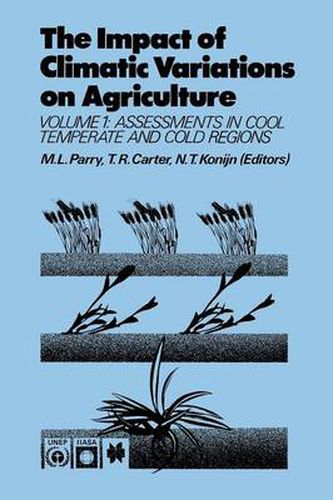Readings Newsletter
Become a Readings Member to make your shopping experience even easier.
Sign in or sign up for free!
You’re not far away from qualifying for FREE standard shipping within Australia
You’ve qualified for FREE standard shipping within Australia
The cart is loading…






This title is printed to order. This book may have been self-published. If so, we cannot guarantee the quality of the content. In the main most books will have gone through the editing process however some may not. We therefore suggest that you be aware of this before ordering this book. If in doubt check either the author or publisher’s details as we are unable to accept any returns unless they are faulty. Please contact us if you have any questions.
Three important studies were initiated in the 1970s to investigate the relation ship between climatic variations and agriculture: by the National Delcnse University (1980) on Crop Yields and Climate Change to the Year 2000, by the U.s. Department of Transportation (1975) on Impacts of Climatic Change on the Biosphere and by the U.S. Department of Energy (1980) on Environmental and Societal Consequences of a Possible CO -Induced Climatic Change (the ClAP 2 study). These were pioneering projects in a young field. Their emphasis was on measuring likely impacts of climatic variations rather than on evaluating possible responses, and they focused on first-order impacts (e.g., on crop yields) rather than on higher-order effects on society. A logical next step was to look at higher-order effects and potential responses, as part of a more integrated approach to impact assessment. This was undertaken by the World Climate Impact Program (WCIP), which is directed by the United Nations Environment Program (UNEP). The WCIP is one of four aspects of the World Climate Program that was initiated in 1979. At a meeting in 1982, the Scientific Advisory Committee of WCIP accepted, in broad terms, a proposal from the International Institute for Applied Systems Analysis (IIASA) for an integrated climate impact assessment, with the proviso that the emphasis be on impacts in the agricultural sector. Martin Parry was asked to design and direct the project at IIASA. Funding was provided by UNEP, IIASA, the Austrian Government and the United Nations University.
$9.00 standard shipping within Australia
FREE standard shipping within Australia for orders over $100.00
Express & International shipping calculated at checkout
This title is printed to order. This book may have been self-published. If so, we cannot guarantee the quality of the content. In the main most books will have gone through the editing process however some may not. We therefore suggest that you be aware of this before ordering this book. If in doubt check either the author or publisher’s details as we are unable to accept any returns unless they are faulty. Please contact us if you have any questions.
Three important studies were initiated in the 1970s to investigate the relation ship between climatic variations and agriculture: by the National Delcnse University (1980) on Crop Yields and Climate Change to the Year 2000, by the U.s. Department of Transportation (1975) on Impacts of Climatic Change on the Biosphere and by the U.S. Department of Energy (1980) on Environmental and Societal Consequences of a Possible CO -Induced Climatic Change (the ClAP 2 study). These were pioneering projects in a young field. Their emphasis was on measuring likely impacts of climatic variations rather than on evaluating possible responses, and they focused on first-order impacts (e.g., on crop yields) rather than on higher-order effects on society. A logical next step was to look at higher-order effects and potential responses, as part of a more integrated approach to impact assessment. This was undertaken by the World Climate Impact Program (WCIP), which is directed by the United Nations Environment Program (UNEP). The WCIP is one of four aspects of the World Climate Program that was initiated in 1979. At a meeting in 1982, the Scientific Advisory Committee of WCIP accepted, in broad terms, a proposal from the International Institute for Applied Systems Analysis (IIASA) for an integrated climate impact assessment, with the proviso that the emphasis be on impacts in the agricultural sector. Martin Parry was asked to design and direct the project at IIASA. Funding was provided by UNEP, IIASA, the Austrian Government and the United Nations University.